Click on the button below to go to the offer of this German-speaking host.
County: Sibiu
Website: hiltonhotels.com
Telefon: +40 (0)269 505 600
Address: Sibiu (Sibiu, PLZ: 550399), Strada Pădurea Dumbrava Nr. 1, County Sibiu, Romania
Our UiR database: What you can also visit and explore nearby ...

Brateiu commune / fortified church | Sibiu County
(14 November 2025)
X

(14 November 2025)
Brateiu (also Bratei; German: Pretai, Transylvanian Saxon: Pretai or Pretua, Hungarian: Barathely) is a commune in Sibiu County.
The village was founded by German settlers and was first mentioned in 1283 as Mons Mariae (Marienberg). The village experienced its heyday towards the end of the 18th century. After complaints to Emperor Joseph II about the poor condition of the fortified church, which was in danger of collapsing — as it was built on marshy ground — were successful, the commune was expanded towards Schäßburg, the natural course of the Kokel river was diverted, and the surrounding marsh was drained.
Pictures: middle October 2025
The village was founded by German settlers and was first mentioned in 1283 as Mons Mariae (Marienberg). The village experienced its heyday towards the end of the 18th century. After complaints to Emperor Joseph II about the poor condition of the fortified church, which was in danger of collapsing — as it was built on marshy ground — were successful, the commune was expanded towards Schäßburg, the natural course of the Kokel river was diverted, and the surrounding marsh was drained.
Pictures: middle October 2025

Christmas markets / Christmas (Xmas) in Romania
(13 November 2025)
X

(13 November 2025)
It all starts tomorrow! In Sibiu / Hermannstadt and also in Craiova, the first Christmas markets in Romania will begin on Friday, November 14, 2025.
https://urlaub-in-rumänien.de/de/uir/weihnachtsmaerkte-in-rumaenien/
Pictures from previous years from both Christmas markets.
https://urlaub-in-rumänien.de/de/uir/weihnachtsmaerkte-in-rumaenien/
Pictures from previous years from both Christmas markets.

Dumbraveni (German: Elisabethstadt) | Sibiu County
(13 November 2025)
X

(13 November 2025)
Autumn impressions from Dumbraveni (German: Elisabethstadt; Saxon dialect: Eppeschdorf, Hungarian: Erzsébetváros), a town in the north of Sibiu County.
For a good night's stay and delicious regional specialties, you can find them here:
https://pensionkokel.ro | https://bistrotecabaum.ro
The town is located on the banks of the Tarnava Mare river, about 20 km east of the town of Medias. It lies on the Transylvanian Plateau, on the border with Mures County, halfway between Medias and Sighisoara / Schäßburg.
For a good night's stay and delicious regional specialties, you can find them here:
https://pensionkokel.ro | https://bistrotecabaum.ro
The town is located on the banks of the Tarnava Mare river, about 20 km east of the town of Medias. It lies on the Transylvanian Plateau, on the border with Mures County, halfway between Medias and Sighisoara / Schäßburg.

Pension Kokel & Bistroteca / Restaurant Baum | Sibiu County
(11 November 2025)
X

(11 November 2025)
Between Schäßburg (Sighisoara) and Medias lies the town of Dumbrăveni, the ideal starting point to discover the “treasures of Transylvania.” Fortified churches, medieval castles, picturesque hiking trails and unforgettable cultural events.
https://pensionkokel.ro | https://bistrotecabaum.ro
At Pension Kokel you will find a true oasis of Transylvanian calm and the warmth of a family atmosphere, where traditional charm harmoniously blends with modern comfort. The guesthouse offers 12 luxurious rooms, lovingly furnished for comfort and relaxation — perfect for guests seeking peace and privacy in an elegant setting.
The house also features a breakfast room, a restaurant, a bar, a terrace, a SPA area, a fitness room, a children's Playground and private parking.
And if you want a tasty meal, be sure to visit the Bistroteca / Restaurant Baum.
https://pensionkokel.ro | https://bistrotecabaum.ro
At Pension Kokel you will find a true oasis of Transylvanian calm and the warmth of a family atmosphere, where traditional charm harmoniously blends with modern comfort. The guesthouse offers 12 luxurious rooms, lovingly furnished for comfort and relaxation — perfect for guests seeking peace and privacy in an elegant setting.
The house also features a breakfast room, a restaurant, a bar, a terrace, a SPA area, a fitness room, a children's Playground and private parking.
And if you want a tasty meal, be sure to visit the Bistroteca / Restaurant Baum.

Castles | Fortresses | Fortified churches in Romania
(10 November 2025)
X

(10 November 2025)
Fans of castles, fortresses, palaces, and everything related will get their money’s worth on a holiday in Romania 🥰
Hunedoara / Corvin Castle, Hunedoara County | Bran Castle / Törzburg, Brasov County | Peles and Pelisor Castles, Sinaia, Prahova County | Cantacuzino Castle, Busteni, Prahova County | Fortified church of Biertan / Birthälm, Sibiu County | Defensive walls of Sibiu / Hermannstadt | Rasnov / Rosenau Fortress, Brasov County | and many other places invite you to visit.
https://urlaub-in-rumänien.de/de/ausflugsziele-reiseziele-rumaenien-burgen-schloesser/
Hunedoara / Corvin Castle, Hunedoara County | Bran Castle / Törzburg, Brasov County | Peles and Pelisor Castles, Sinaia, Prahova County | Cantacuzino Castle, Busteni, Prahova County | Fortified church of Biertan / Birthälm, Sibiu County | Defensive walls of Sibiu / Hermannstadt | Rasnov / Rosenau Fortress, Brasov County | and many other places invite you to visit.
https://urlaub-in-rumänien.de/de/ausflugsziele-reiseziele-rumaenien-burgen-schloesser/

5 days left | Christmas market in Sibiu / Hermannstadt
(09 November 2025)
X

(09 November 2025)
Pictures from the last Christmas market 2024 in the center of Hermannstadt (Sibiu)... but soon, very soon, it will be that time again, the Christmas market in Sibiu will open as early as November 14 🥰
Overview of Christmas markets in Romania:
https://urlaub-in-rumänien.de/de/uir/weihnachtsmaerkte-in-rumaenien/
We thank Mrs. Camelia Stefan and Mrs. Heide Göddert for sending these pictures. Thank you > https://heide-reisen.de
Overview of Christmas markets in Romania:
https://urlaub-in-rumänien.de/de/uir/weihnachtsmaerkte-in-rumaenien/
We thank Mrs. Camelia Stefan and Mrs. Heide Göddert for sending these pictures. Thank you > https://heide-reisen.de

Soon again! | The Ice Hotel at Balea Lake
(07 November 2025)
X

(07 November 2025)
Do you know the Ice Hotel at Balea Lake? Not yet... then it’s time for a trip this coming winter 🥰
https://www.hotelofice.ro
The hotel is rebuilt every year (planned opening December 23, 2025) and simply melts away again in early summer 😅. Due to its location (at 2,034 meters, Fagaras Mountains, Sibiu County), cold and long winters are guaranteed, and besides the wonderful winter landscape, it is another highlight of this region.
Balea Lake can be reached by cable car / gondola (3.7 km, Monday to Sunday from 9:00 a.m. to 5:00 p.m.). The starting point for the cable car is Balea Waterfall (Cabana Balea Cascada). The hotel usually opens in mid / late December and has a season of about 4 months (depending on the weather and winter conditions).
Pictures from one of the last "hotel seasons" from previous years.
https://www.hotelofice.ro
The hotel is rebuilt every year (planned opening December 23, 2025) and simply melts away again in early summer 😅. Due to its location (at 2,034 meters, Fagaras Mountains, Sibiu County), cold and long winters are guaranteed, and besides the wonderful winter landscape, it is another highlight of this region.
Balea Lake can be reached by cable car / gondola (3.7 km, Monday to Sunday from 9:00 a.m. to 5:00 p.m.). The starting point for the cable car is Balea Waterfall (Cabana Balea Cascada). The hotel usually opens in mid / late December and has a season of about 4 months (depending on the weather and winter conditions).
Pictures from one of the last "hotel seasons" from previous years.

Soon again! | The Ice Hotel at Balea Lake
(07 November 2025)
X

(07 November 2025)
Do you know the Ice Hotel at Balea Lake? Not yet... then it’s time for a trip this coming winter 🥰
https://www.hotelofice.ro
The hotel is rebuilt every year (planned opening December 23, 2025) and simply melts away again in early summer 😅. Due to its location (at 2,034 meters, Fagaras Mountains, Sibiu County), cold and long winters are guaranteed, and besides the wonderful winter landscape, it is another highlight of this region.
Balea Lake can be reached by cable car / gondola (3.7 km, Monday to Sunday from 9:00 a.m. to 5:00 p.m.). The starting point for the cable car is Balea Waterfall (Cabana Balea Cascada). The hotel usually opens in mid / late December and has a season of about 4 months (depending on the weather and winter conditions).
Pictures from one of the last "hotel seasons" from previous years.
https://www.hotelofice.ro
The hotel is rebuilt every year (planned opening December 23, 2025) and simply melts away again in early summer 😅. Due to its location (at 2,034 meters, Fagaras Mountains, Sibiu County), cold and long winters are guaranteed, and besides the wonderful winter landscape, it is another highlight of this region.
Balea Lake can be reached by cable car / gondola (3.7 km, Monday to Sunday from 9:00 a.m. to 5:00 p.m.). The starting point for the cable car is Balea Waterfall (Cabana Balea Cascada). The hotel usually opens in mid / late December and has a season of about 4 months (depending on the weather and winter conditions).
Pictures from one of the last "hotel seasons" from previous years.

Alba Iulia / Karlsburg | Alba County
(06 November 2025)
X

(06 November 2025)
On the way from Timisoara to Sibiu or from Cluj Napoca to Sibiu (both on the highway), or of course also in the opposite direction, you should not miss a detour to Alba Iulia.
https://urlaub-in-rumänien.de/en/uir/destinations-romania-alba-iulia/
https://urlaub-in-rumänien.de/en/uir/destinations-romania-alba-iulia/

Christmas markets in Romania | Only 10 days left
(05 November 2025)
X

(05 November 2025)
In 10 days, the first Christmas markets in Romania will already open... Craiova, Hermannstadt / Sibiu, and certainly several more. We’ll keep an eye on things (the snow globe ☺️) and will regularly and comprehensively inform you about the most beautiful Christmas markets in Romania.
https://urlaub-in-rumänien.de/de/uir/weihnachtsmaerkte-in-rumaenien/
Pictures: Christmas markets in Hermannstadt / Sibiu, Bucharest, Targu Mures, and Timisoara from previous years.
https://urlaub-in-rumänien.de/de/uir/weihnachtsmaerkte-in-rumaenien/
Pictures: Christmas markets in Hermannstadt / Sibiu, Bucharest, Targu Mures, and Timisoara from previous years.

Kerz Monastery (Cârța) in Transylvania | Sibiu County
(05 November 2025)
X

(05 November 2025)
Cârța Monastery (German: Kerz) is a former Cistercian (Benedictine) monastery in Transylvania, Romania.
It is located on the left bank of the Olt River, almost exactly halfway between the towns of Sibiu and Făgăraș, and today serves as an Evangelical Lutheran church.
The exact founding date of Cârța Monastery (Latin: monasterium beatae Mariae virginis in Candelis de Kerch) is unknown. A Konstanz document dated 17 April 1418, issued by Sigismund, King of Hungary, vaguely states that the monastery was founded, built and endowed with rights and privileges by its predecessors. Cistercian documents collected and analysed by Leopold Janauschek from the 13th–15th centuries mention the monastery’s founding around 1202–1203.
Beautiful pictures by Mr. Iercosan Marian from a few days ago (end of September 2025).
It is located on the left bank of the Olt River, almost exactly halfway between the towns of Sibiu and Făgăraș, and today serves as an Evangelical Lutheran church.
The exact founding date of Cârța Monastery (Latin: monasterium beatae Mariae virginis in Candelis de Kerch) is unknown. A Konstanz document dated 17 April 1418, issued by Sigismund, King of Hungary, vaguely states that the monastery was founded, built and endowed with rights and privileges by its predecessors. Cistercian documents collected and analysed by Leopold Janauschek from the 13th–15th centuries mention the monastery’s founding around 1202–1203.
Beautiful pictures by Mr. Iercosan Marian from a few days ago (end of September 2025).

Făgăraș Fortress | Brașov County
(04 November 2025)
X

(04 November 2025)
On the way from Sibiu to Brașov lies the town of Făgăraș. At the end of the 12th century the town's fortress was only a wooden fortification, which was expanded into a stone fortress in the 14th century.
The fortress houses a museum, which—like the fortress itself—can be visited. Directly next to the fortress is the cathedral / church Sfantul Ioan Botezatorul.
Beautiful pictures by Mr. Iercosan Marian from a few days ago (end of September 2025).
The fortress houses a museum, which—like the fortress itself—can be visited. Directly next to the fortress is the cathedral / church Sfantul Ioan Botezatorul.
Beautiful pictures by Mr. Iercosan Marian from a few days ago (end of September 2025).

Transylvania | Siebenbürgen
(02 November 2025)
X

(02 November 2025)
Peles Castle in Prahova County, the city of Sighisoara in Mures County, Corvin Castle in Hunedoara County, and the city of Sibiu (Hermannstadt).
https://urlaub-in-rumänien.de | https://welcome-to-romania.com
https://urlaub-in-rumänien.de | https://welcome-to-romania.com

Biserica Romano-Catolica Sfanta Treime | Hermannstadt / Sibiu
(02 November 2025)
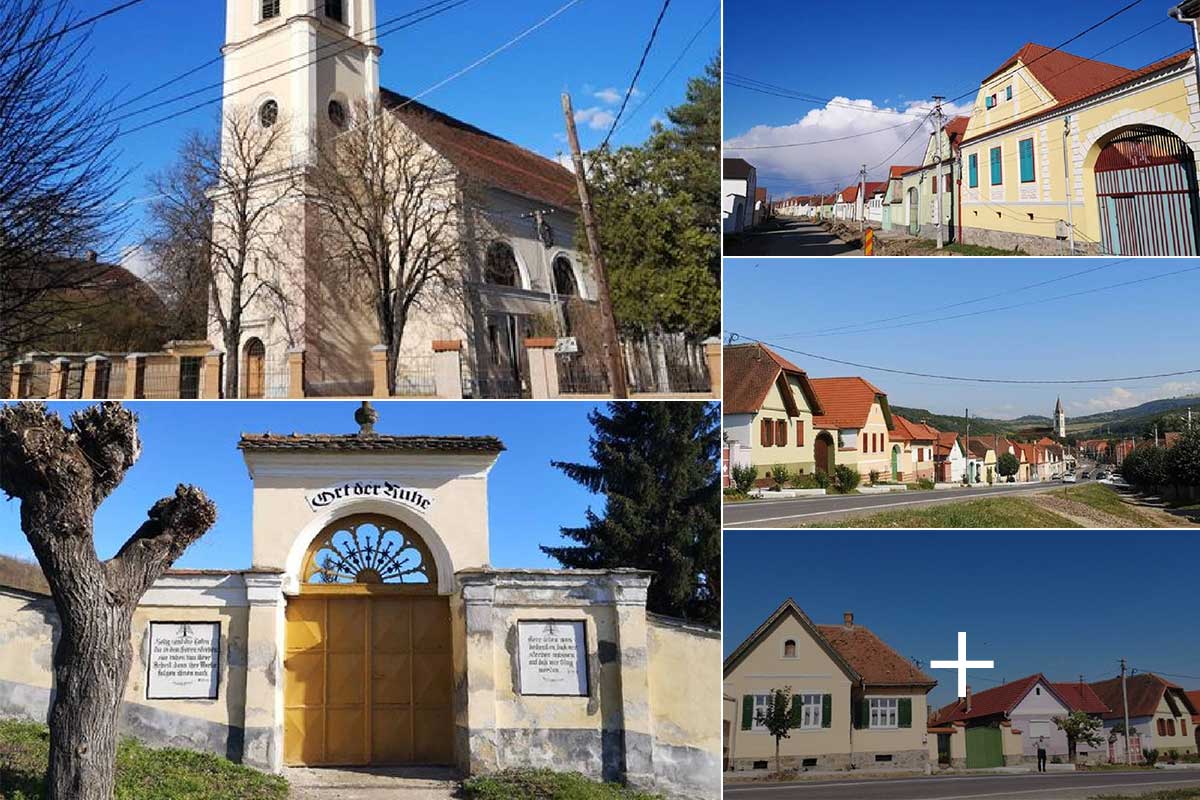
Großpold / Apoldu de Sus | Sibiu County
(02 November 2025)
X

(02 November 2025)
The village of Großpold, in Romanian Apoldu de Sus, is located in the county of Sibiu and is one of the three so-called Landler villages in Transylvania.
The Landler were forced to leave their Austrian homeland in the 18th century due to their Protestant faith and settled mainly in three villages near Sibiu. They have preserved their language and traditional costumes to this day. In Großpold, the typical architecture of the houses has largely been preserved. The two other Landler villages are Neppendorf, in Romanian Turnisor, today incorporated into Sibiu, and Großau, in Romanian Cristian.
We would like to thank Mr. Frank Schleßmann for sending us these beautiful pictures and the corresponding text/explanation.
The Landler were forced to leave their Austrian homeland in the 18th century due to their Protestant faith and settled mainly in three villages near Sibiu. They have preserved their language and traditional costumes to this day. In Großpold, the typical architecture of the houses has largely been preserved. The two other Landler villages are Neppendorf, in Romanian Turnisor, today incorporated into Sibiu, and Großau, in Romanian Cristian.
We would like to thank Mr. Frank Schleßmann for sending us these beautiful pictures and the corresponding text/explanation.

Pardon Cafe Bar & Restaurant | Sibiu / Hermannstadt
(01 November 2025)
X

(01 November 2025)
Only about 150 meters southeast of the Great Square (Piata Mare), right in the center of Sibiu / Hermannstadt, you will find Pardon Cafe Bar & Restaurant with its beautiful outdoor terrace.
Pardon Cafe Bar & Restaurant | https://pardoncafesibiu.ro
The restaurant offers a wide variety of European, Romanian, and also local dishes of the region.
We thank Mrs. Meli Döring for granting permission to use these pictures (August 2025). Thank you 😊
Pardon Cafe Bar & Restaurant | https://pardoncafesibiu.ro
The restaurant offers a wide variety of European, Romanian, and also local dishes of the region.
We thank Mrs. Meli Döring for granting permission to use these pictures (August 2025). Thank you 😊

Sibiu / Hermannstadt at night | End of September 2025
(01 November 2025)
X

(01 November 2025)
Beautiful in every season, by day and by night ... Hermannstadt / Sibiu / Nagyszeben in Transylvania.
The old town and the city's fortification walls were built by Saxon settlers (the Transylvanian Saxons) in the 12th and 13th centuries and are still preserved today in many of their original features.
Beautiful pictures by Mr. Iercosan Marian from a few days ago (end of September 2025).
The old town and the city's fortification walls were built by Saxon settlers (the Transylvanian Saxons) in the 12th and 13th centuries and are still preserved today in many of their original features.
Beautiful pictures by Mr. Iercosan Marian from a few days ago (end of September 2025).

Medias in Sibiu County in autumn
(26 October 2025)
X

(26 October 2025)
Beautiful pictures from the city of Medias (Sibiu County) from September 2025 and our dear Roland on site 🥰
We are always happy to receive current pictures and travel reports from all over Romania. If you (and our readers/followers) would like to share, please just send them to us as a PM or via WhatsApp (+40 (0)773 947 438) with your name. Thank you 😊
We are always happy to receive current pictures and travel reports from all over Romania. If you (and our readers/followers) would like to share, please just send them to us as a PM or via WhatsApp (+40 (0)773 947 438) with your name. Thank you 😊

Dumbraveni (German: Elisabethstadt) from above | Sibiu County
(26 October 2025)
X

(26 October 2025)
From above... Dumbraveni (German: Elisabethstadt; Saxon dialect: Eppeschdorf, Hungarian: Erzsébetváros) in autumn, a town in the north of Sibiu County.
For a good night's stay and delicious regional specialties, you can find them here:
https://pensionkokel.ro | https://bistrotecabaum.ro
The town is located on the banks of the Tarnava Mare river, about 20 km east of Medias. It lies on the Transylvanian Plateau, on the border with Mures County, halfway between Medias and Sighisoara / Schäßburg.
For a good night's stay and delicious regional specialties, you can find them here:
https://pensionkokel.ro | https://bistrotecabaum.ro
The town is located on the banks of the Tarnava Mare river, about 20 km east of Medias. It lies on the Transylvanian Plateau, on the border with Mures County, halfway between Medias and Sighisoara / Schäßburg.
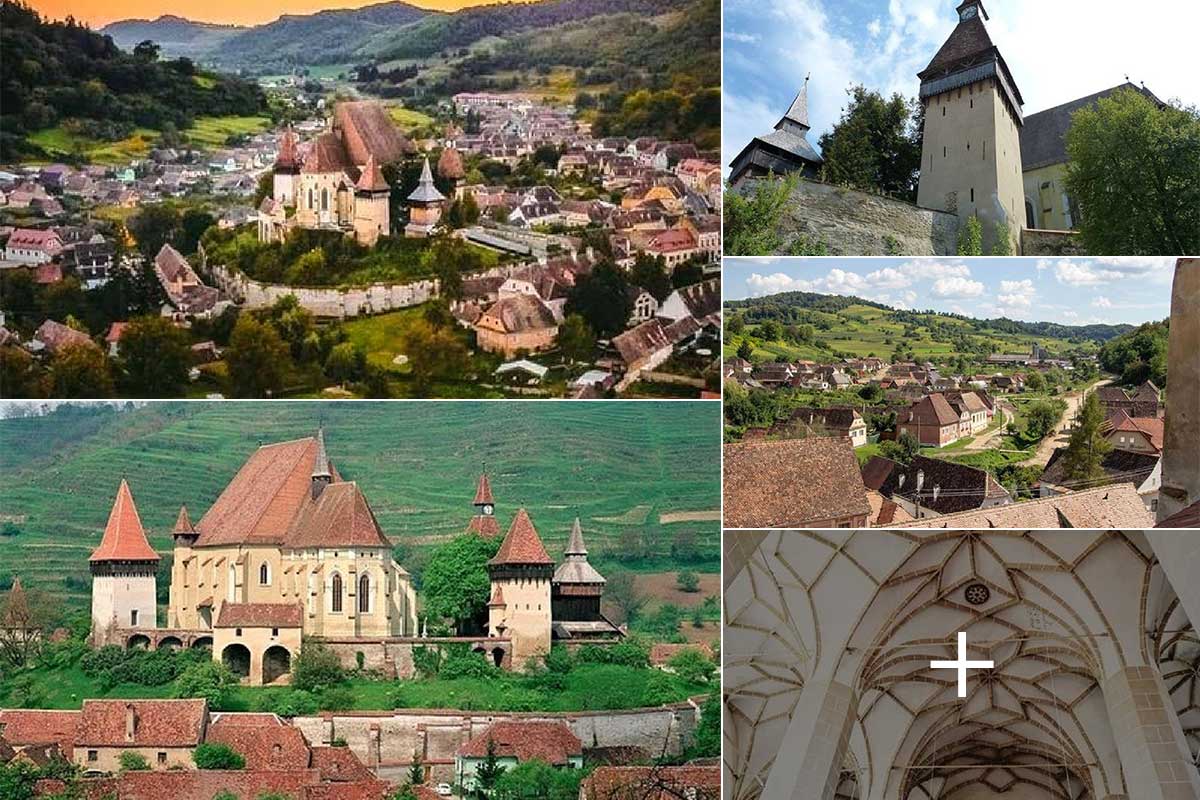
The fortified church / fortified church Biertan
(22 October 2025)
X

(22 October 2025)
The church is located in the commune of Biertan in Sibiu County, Transylvania. Biertan is part of the first German-Saxon settlements and was already mentioned in documents in 1398 (other sources: 1402).
Like every Saxon settlement, it stands out through a series of villages arranged around a central square, above which the imposing fortified church rises. Between 1572 and 1867, Biertan was the seat of the Saxon episcopate (bishopric of the Evangelical Church A.B.), which favored the development of one of the largest rural communities in Transylvania around this fortified church.
It is a medieval and architectural treasure of Romania, definitely worth a visit.
We thank Go_out_Romania for granting permission to use some of the pictures.
Like every Saxon settlement, it stands out through a series of villages arranged around a central square, above which the imposing fortified church rises. Between 1572 and 1867, Biertan was the seat of the Saxon episcopate (bishopric of the Evangelical Church A.B.), which favored the development of one of the largest rural communities in Transylvania around this fortified church.
It is a medieval and architectural treasure of Romania, definitely worth a visit.
We thank Go_out_Romania for granting permission to use some of the pictures.
We thank Go_out_Romania for the permission to use this image(s)

Christmas Markets in Romania | In just 25 days
(21 October 2025)
X

(21 October 2025)
In just 25 days the first Christmas market in Romania will open. Hermannstadt / Sibiu and Craiova are always among the first markets (from November 14).
Anyone who wants to experience one (or several) of the beautiful Christmas markets in Romania should start planning now.
Always up-to-date information on all Christmas markets:
https://urlaub-in-rumänien.de/de/uir/weihnachtsmaerkte-in-rumaenien/
This post: Pictures from previous Christmas markets. Thanks to the markets and the photographers for granting permission to use the pictures.
Anyone who wants to experience one (or several) of the beautiful Christmas markets in Romania should start planning now.
Always up-to-date information on all Christmas markets:
https://urlaub-in-rumänien.de/de/uir/weihnachtsmaerkte-in-rumaenien/
This post: Pictures from previous Christmas markets. Thanks to the markets and the photographers for granting permission to use the pictures.

Medias ... autumn impressions | Sibiu County
(19 October 2025)
X

(19 October 2025)
Medias (German: Mediasch, Hungarian: Medgyes, and in Saxon: Medwesch, Medves or Meddesch) is a town / commune in Sibiu County in Transylvania. It consists of the town of Medias and the village of Ighisu Nou (German: Sächsisch-Eibesdorf) and has about 55,000 inhabitants. After Sibiu, Medias is the second largest and most populous city in Sibiu County.
Pictures / impressions from autumn, October 17, 2025 🍂🥰
In Roman times, there was a Roman fortress called "Media" on the territory of today’s city. Later, in the 12th and 13th centuries, the Hungarian kings settled Germans and Western European colonists, known as the Transylvanian Saxons, in this area of Medias.
Pictures / impressions from autumn, October 17, 2025 🍂🥰
In Roman times, there was a Roman fortress called "Media" on the territory of today’s city. Later, in the 12th and 13th centuries, the Hungarian kings settled Germans and Western European colonists, known as the Transylvanian Saxons, in this area of Medias.

Holiday destination 2026: Hermannstadt (Sibiu) in Transylvania
(18 October 2025)
X

(18 October 2025)
The old town / city center of Sibiu in recent pictures from April 12 and 13, 2025. Hermannstadt (Romanian: Sibiu, Hungarian: Nagyszeben, and Transylvanian Saxon: Hermestatt) is the county seat of the county of the same name in the historical region of Transylvania.
It is believed that the first German settlers arrived in the area in 1147. The first documentary mention of the city dates from 1191. From 1223 the Latin name "Villa Hermanni" is attested, and from 1241 the German equivalent Hermannstorf.
We thank Mr. Frank Schleßmann for sending the pictures and for granting permission to use them.
It is believed that the first German settlers arrived in the area in 1147. The first documentary mention of the city dates from 1191. From 1223 the Latin name "Villa Hermanni" is attested, and from 1241 the German equivalent Hermannstorf.
We thank Mr. Frank Schleßmann for sending the pictures and for granting permission to use them.

Holiday destination 2026: Hermannstadt (Sibiu) in Transylvania
(18 October 2025)
X

(18 October 2025)
The old town / city center of Sibiu in recent pictures from April 12 and 13, 2025. Hermannstadt (Romanian: Sibiu, Hungarian: Nagyszeben, and Transylvanian Saxon: Hermestatt) is the county seat of the county of the same name in the historical region of Transylvania.
It is believed that the first German settlers arrived in the area in 1147. The first documentary mention of the city dates from 1191. From 1223 the Latin name "Villa Hermanni" is attested, and from 1241 the German equivalent Hermannstorf.
We thank Mr. Frank Schleßmann for sending the pictures and for granting permission to use them.
It is believed that the first German settlers arrived in the area in 1147. The first documentary mention of the city dates from 1191. From 1223 the Latin name "Villa Hermanni" is attested, and from 1241 the German equivalent Hermannstorf.
We thank Mr. Frank Schleßmann for sending the pictures and for granting permission to use them.

Medias ... autumn impressions | Sibiu County
(18 October 2025)
X

(18 October 2025)
Medias (German: Mediasch, Hungarian: Medgyes, and in Saxon: Medwesch, Medves or Meddesch) is a town / commune in Sibiu County in Transylvania. It consists of the town of Medias and the village of Ighisu Nou (German: Sächsisch-Eibesdorf) and has about 55,000 inhabitants. After Sibiu, Medias is the second largest and most populous city in Sibiu County.
Pictures / impressions from autumn, October 17, 2025 🍂🥰
In Roman times, there was a Roman fortress called "Media" on the territory of today’s city. Later, in the 12th and 13th centuries, the Hungarian kings settled Germans and Western European colonists, known as the Transylvanian Saxons, in this area of Medias.
Pictures / impressions from autumn, October 17, 2025 🍂🥰
In Roman times, there was a Roman fortress called "Media" on the territory of today’s city. Later, in the 12th and 13th centuries, the Hungarian kings settled Germans and Western European colonists, known as the Transylvanian Saxons, in this area of Medias.

Bazna commune / fortified church in autumn | Sibiu County
(17 October 2025)
X

(17 October 2025)
Pictures from yesterday (16.10.2025) from Bazna (German: Baaßen or Baassen, Transylvanian Saxon: Baußen or Boassen, Hungarian: Bazna or Felsőbajom), located in the historical region of Siebenbürgen / Transylvania.
The commune is situated in the Kokel valley in the north of Sibiu County, about 15 kilometers northwest of the town of Medias and about 70 kilometers north of the county capital Sibiu / Hermannstadt.
King Stephen V (King of Hungary from 1270 to 1272) gave the place to the son of Count Bozouch. In 1302, Baaßen was mentioned for the first time in a document. In 1359 it was referred to as a free commune of the "Königsboden", belonging to the Medias seat. The German colonists first settled on the hill at the back, and later the village developed in the front valley.
Thanks to dear Roland for the wonderful pictures from 16.10.2025 🥰
The commune is situated in the Kokel valley in the north of Sibiu County, about 15 kilometers northwest of the town of Medias and about 70 kilometers north of the county capital Sibiu / Hermannstadt.
King Stephen V (King of Hungary from 1270 to 1272) gave the place to the son of Count Bozouch. In 1302, Baaßen was mentioned for the first time in a document. In 1359 it was referred to as a free commune of the "Königsboden", belonging to the Medias seat. The German colonists first settled on the hill at the back, and later the village developed in the front valley.
Thanks to dear Roland for the wonderful pictures from 16.10.2025 🥰
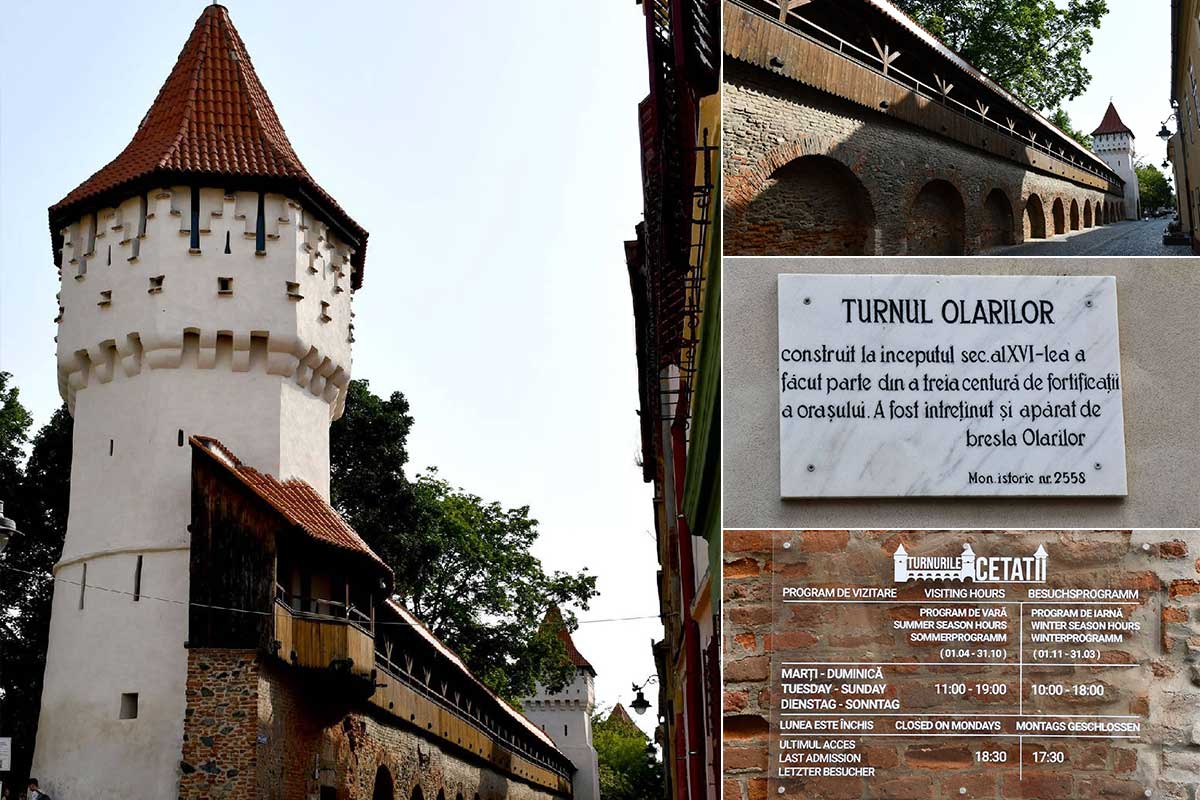
Hermannstadt | Sibiu | Citadel Turnues
(15 October 2025)
X

(15 October 2025)
The carpenter's storm in Sibiu / Sibiu ( in Romanian: The carpenters' Tower ) was in the 14th century. 17th century built by the Saxon carpenter's guild in Hermannstadt.
The tower was part of the city's third fortified belt and is today the left tower, the defensive wall and the fortress still preserved. It is located on Zitadellenstraße ( Harteneckgasse, named after Mayor Johann Sachs von Harteneck ).
Pottery Tower ( in Romanian Potters' Tower ) was built in the 15th century by the Saxon guild. It was also part of the city's third fortified belt and is located to the right of the defensive wall and a preserved fortress.
Images: July 2023
The tower was part of the city's third fortified belt and is today the left tower, the defensive wall and the fortress still preserved. It is located on Zitadellenstraße ( Harteneckgasse, named after Mayor Johann Sachs von Harteneck ).
Pottery Tower ( in Romanian Potters' Tower ) was built in the 15th century by the Saxon guild. It was also part of the city's third fortified belt and is located to the right of the defensive wall and a preserved fortress.
Images: July 2023
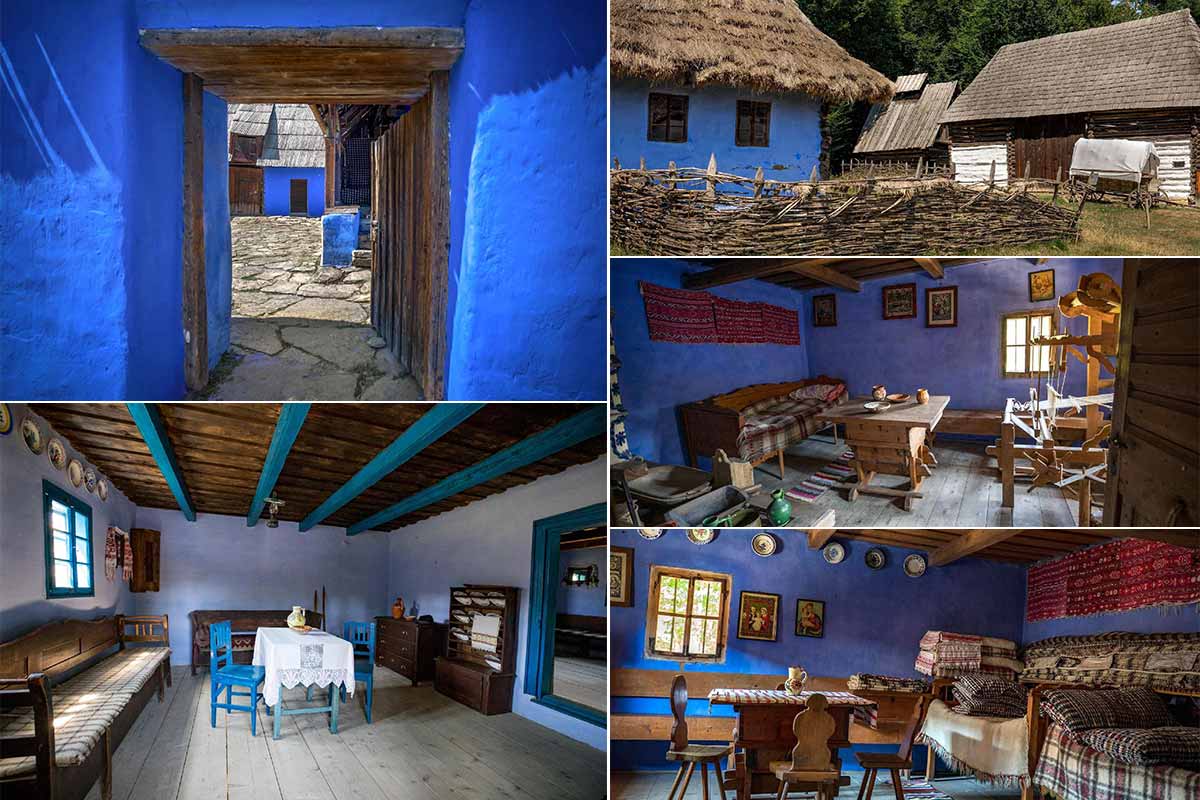
Museum of Traditional Popular Civilization | Sibiu
(15 October 2025)
X

(15 October 2025)
Museum of Traditional Popular Culture in Sibiu (Hermannstadt in German) is one of the largest open-air museums in Romania.
Located just south of Sibiu (German: Hermannstadt), the museum is located in the "Dumbrava Sibiului" forest, on the connecting road between Sibiu and Rășinari, about three kilometers (3) from the city.
Contains installations of traditional pre-industrial Romanian popular civilization. Houses, workshops and construction complexes are scattered around a lake, among the trees of the Sibiu Drumbrates.
We thank Mrs Farkas Ildiko ( facebook.com/farkas.ildiko.75 ) for the permission to use these pictures.
Located just south of Sibiu (German: Hermannstadt), the museum is located in the "Dumbrava Sibiului" forest, on the connecting road between Sibiu and Rășinari, about three kilometers (3) from the city.
Contains installations of traditional pre-industrial Romanian popular civilization. Houses, workshops and construction complexes are scattered around a lake, among the trees of the Sibiu Drumbrates.
We thank Mrs Farkas Ildiko ( facebook.com/farkas.ildiko.75 ) for the permission to use these pictures.
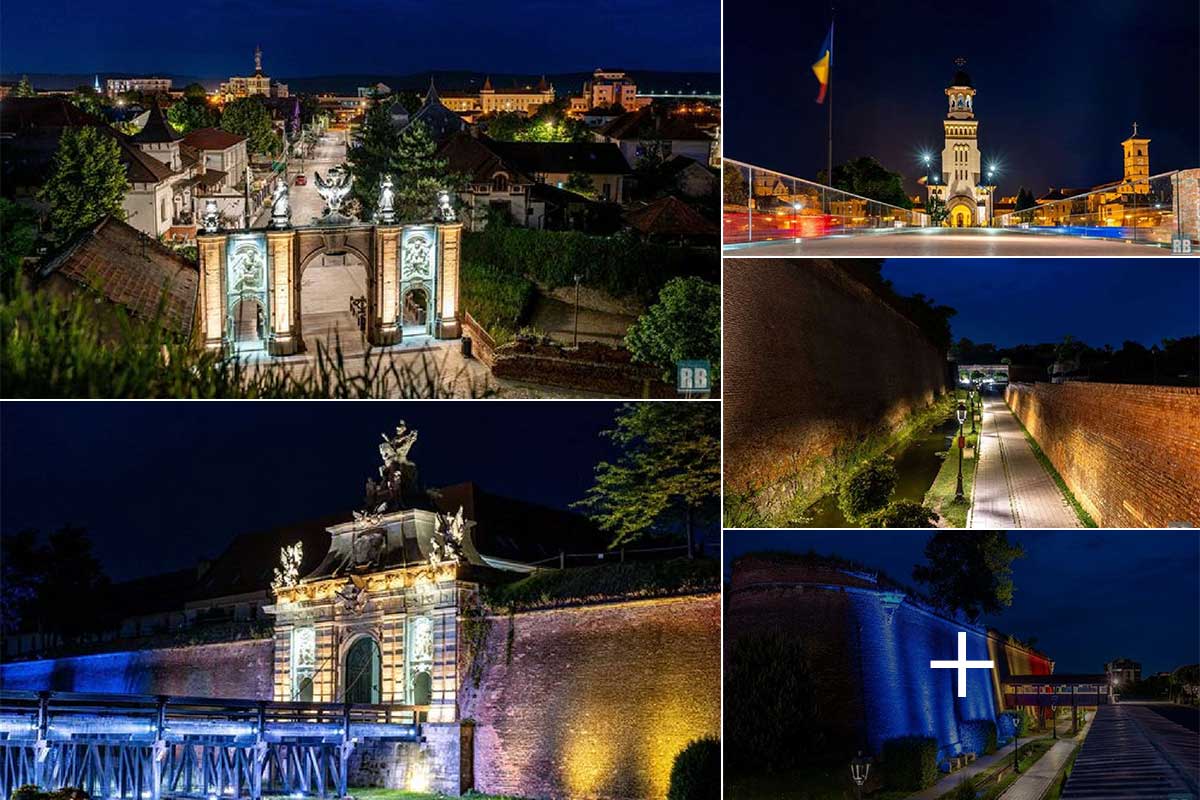
Alba Iulia | Alba Carolina Fortress
(14 October 2025)
X

(14 October 2025)
The Alba Carolina Citadel in Alba Iulia (Karlsburg) was built between 1715 and 1738 under the rule of Emperor Charles VI as a fortification with seven bastions.
It served the Habsburgs as a strategic defense point along the military border with the Ottoman Empire. Alba Iulia is located near the highway on the route to or from Sibiu (Hermannstadt). A visit is definitely worthwhile.
We thank photographer Rene Benner ( facebook.com/rene.benner.1 ) for sending these beautiful images. Thank you!
It served the Habsburgs as a strategic defense point along the military border with the Ottoman Empire. Alba Iulia is located near the highway on the route to or from Sibiu (Hermannstadt). A visit is definitely worthwhile.
We thank photographer Rene Benner ( facebook.com/rene.benner.1 ) for sending these beautiful images. Thank you!

Eight days Transylvania tour | Incl. accommodation & rental car from €489
(11 October 2025)
X

(11 October 2025)
Whether in autumn / winter, spring or summer. The tour operator DRS Reisen GmbH from Stuttgart offers an 8‑day Transylvania tour including accommodation / breakfast, a rental car, itinerary and a city tour in Sibiu / Hermannstadt from €489 per person (price depends on travel dates, based on double room, according to further information from the tour operator).
Provider: DRS Reisen GmbH, Stuttgart, Germany
Travel dates: From September 2025 until the end of 2026
More information / booking at:
https://drs-reisen.de/.../auf-der-historischen-cafes.../
Sibiu / Hermannstadt | Brașov / Kronstadt | Sighisoara / Schäßburg | Count Dracula’s Bran Castle / Törzburg and much more ...
Provider: DRS Reisen GmbH, Stuttgart, Germany
Travel dates: From September 2025 until the end of 2026
More information / booking at:
https://drs-reisen.de/.../auf-der-historischen-cafes.../
Sibiu / Hermannstadt | Brașov / Kronstadt | Sighisoara / Schäßburg | Count Dracula’s Bran Castle / Törzburg and much more ...






